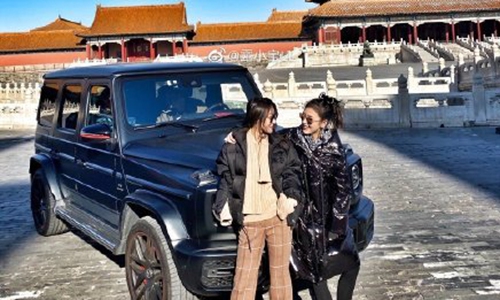HOME >> CHINA
More cars drive into Palace Museum
By Zhang Hui Source:Global Times Published: 2020/1/18 19:58:40

More cases of cars driving into the world-famous Palace Museum in Beijing have been exposed online on Saturday following the two women who drove a private vehicle into the palace premises on Friday that enraged Chinese netizens who slammed the "abuse of privileges" of some people and demanded the museum severely punish those involved.
The Palace Museum has not responded to similar cases as of press time.
Posts of more net users showing off themselves driving into the museum have been exposed by netizens. Some net users claimed they drove into the museum through Donghuamen after using "guanxi," or personal network, and some posted photos of themselves with their cars in front of Taimiao or in cars driving through Shenwumen.
Although these cases were not immediately verified by the Palace Museum, Chinese netizens fiercely slammed those drivers for misusing their social status and also criticized the Palace Museum for allowing cars into its premises and failing to punish those involved.
"Who allowed those private cars into the palace premises? You [Palace Museum] must severely punish the involved employee or employees. Please don't use privileges to roll over cultural relics, history and Chinese netizens' trust in the government!" according to a typical comment from netizens.
Many netizens shared a video of the former director of the Palace Museum Shan Jixiang, who explained the reason behind the restricted entry of vehicles, noting that from Buckingham Palace in the UK to the Palace of Versailles in France, cars are all not allowed as it's a question of respecting culture.
Shan also cited then-French president Fran?ois Hollande, who had to get off his car outside the Palace for a visit in 2013.
Liu Zheng, a member of the China Cultural Relics Academy, told the Global Times that normally, tourists enter the museum through Wumen and staff of the museum enters through Donghuamen.
Visitors could drive through Xihuamen to visit The First Historical Archives of China, and it's likely that visitors further drove into the Palace Museum through the historical archives, Liu said.
He said the archives and the Palace Museum have to strengthen coordination in managing the Xihuamen.
Heavy vehicles could damage the floor tiles of the museum, Liu said.
Zhu Wei, a professor at the China University of Political Science and Law, told the Global Times that drivers could be criminally charged.
Those deliberately damaging national relics face up to 10 years in prison with fines, according to China's criminal law.
Those cases were exposed after photos of two women standing in front of a Mercedes-Benz SUV parked in one of the courtyards of the palace rocked Chinese social media on Friday. A Weibo user named LuxiaobaoLL who posted the photos wrote, "As it's closed on Monday, we avoided visitors flow, and enjoyed the place." Her posts have since been deleted. According to media reports, they stood in the square of Taihemen.
The Palace Museum later confirmed the incident in a statement, and apologized to the public. "We will strictly manage the museum to prevent similar incidents," said the statement on Weibo.
Zhu said that these cases also raised an alarm for other organs of state power and people with privileges to strictly abide by rules.
No one could bypass the rules with privileges. The Palace Museum needs to thoroughly investigate the case and inform public of the results. It would result in irreversible trust and an image crisis if it fails to abide by rules, according to a commentary posted by People's Daily on Weibo.
RELATED ARTICLES:
Posted in: SOCIETY